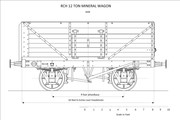RAF96 wrote: ↑Sun Mar 01, 2020 9:25 pm
Could the B’mann wagon be Ho.
I'm not aware of Bachmann producing HO wagons. Trix were one of the first to offer PO wagons, and they worked to some strange scales such as 1/80, and it's possible that some Playcraft and early Lima HO wagons might be around, but they would all look considerably smaller than their OO equivalents.
The early specification from the Railway Clearing House circa 1890 suggested an overall body length of 15', and by their 1923 spec the length was increased to 16' 6", but these were only recommendations, and could be varied by the customer, and the height of the sides was not covered, as that was very dependent on the traffic requirements. The width hardly varied, as it was dependent on many factors such as infrastructure, and wagons for Bristol Channel ports had to be narrower than for other destinations.
The Big Four companies tended towards even longer wagons, such as 17' 6" bodies, and this, coupled with the more modern ironwork and often steel solebar, is why the PO liveries applied to, say, an LMS open, look so wrong to the expert eye. When done well, such as on the Airfix wagons, it is difficult to complain, but if insensitively done, as on many of the commissioned examples, it can look very suspicious.
Walkingthedog wrote: ↑Sun Mar 01, 2020 9:43 pm
Hornby early wagons were always a bit oversized. They have produced the wagons for years. The latest versions are more realistic.
Bachmann being the 'new kid on the block' in the UK compared with Hornby have produced wagons more to scale. I believe Oxford Rail wagons are a bit too small. I don’t care, they all look OK to me.
Tens of thousands of wagons were built so there must have been many differences.
As I noted before, when Bachmann produced their Blue Riband stock they upped the game, but before that they made use of some inaccurate bodies, inherited in part from Mainline, with their intrinsic faults.
At any one time there were up to 700,000 PO wagons on British rails, and, given a life of between twenty and thirty years, the author Len Tavender has estimated that over 1.6 MILLION PO wagons were built, from around 1860 to 1945. In addition they would have been repainted several times in their life, perhaps even rebranded or rebuilt on occasion, adding to the variety. All painting and lettering was done by hand, no vinyls then, so much depended on the skills of the workers, and there are some examples where spacing and letter sizes and shapes have gone slightly awry, giving a slightly comic effect.
The amount of documentation that exists can only touch upon a tiny percentage of that enormous fleet, not even the tip of the iceberg, so there is much that is unknown, and almost anything is possible, within reason, but, on the other hand, in recent years much has appeared in print, largely thanks to Lightmoor Press, so there is plenty of accurate information available to get things right.
